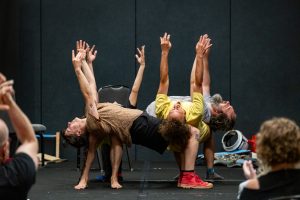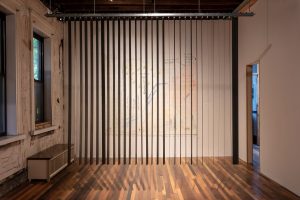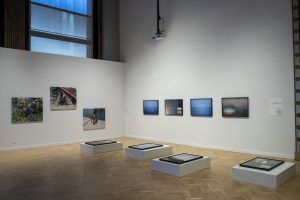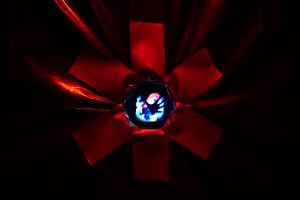On the second floor of the South Asia Institute, there is a large white-cube gallery space which I’ve encountered once before, as the venue for the South Asia Institute’s Desi Queer Open Mic nearly a year ago. Then, as a young South Asian queer person finding my feet in the city after some time away, I was delighted to spend time with my peers sharing their creative endeavors, and finding a supportive community in each other. When I revisit it today, it is to explore the exhibition curated by Ankit Khadgi, People Who Came Before Us—named, aptly, for the desi queers who traversed the city in the decades before we were able to put on events like that open mic in June of 2023.
Rather than being used as a performance area with a stage at the front, the gallery is sectioned off into a few smaller environments, like the sets of plays. The first and most elaborately furnished section has the distinct feeling of a familiar apartment: a living room with a couch and photos of friends hung above it, coffee table, rug, armchair, and some magazines spread across a table, as though someone living here has just left the room. The images, primarily of Ifti Nasim and his friends, aren’t framed, but pasted up like a collage. The room looks organically lived-in by a Chicagoan to have people over for dinner, cultivating a cozy haven for friends to gather. Hints about the time period are all around: the magazines on the large, low coffee table are from the mid-1990s, the shelves are stacked with CD cases, and the television is a small grainy monitor set atop a side table. The scene is welcoming, warmly lit, and we are encouraged to sit and flip through the artifacts.
After getting comfortable on the couch, I went on autopilot and pored through the magazines on the table, and was drawn into a community’s discourse, relevant news, and hot topics. Pieces about safe sex practices amid the AIDS epidemic are published alongside confessionals about desire and political news. These magazines are old issues of Trikone, a South Asian queer magazine which ran from 1986 through the early 2010s. Some of the same deeply personal conversations we have in our living rooms today—the meaning and value of “diaspora” as a political entity, how we feel with South Asian lovers as opposed to other racial groups—are the issues grappled with decades ago as well, with this magazine as a primary outlet for many who were otherwise isolated or closeted. A melange of sexy, political, gossipy, educational, entertaining, and opinion pieces, these magazines reflect the room itself: complex, detailed, and an invitation into a rich existing place.
The degree of intimacy cultivated with the authors and implied former inhabitants of this room is uncanny. Building a relationship to a set of archives without an intact community today is a fundamental challenge of searching for the history of communities that are scattered, no longer with us, or otherwise not readily available for dialogue. Knowing our histories becomes imaginative work in these circumstances. The immersive experience of feeling as though someone has just left the room offers a sense of continuity, and the comforting idea that you are stepping into something that has been built for you. In art galleries and queer archives alike, these are feelings that can be challenging to find as a young South Asian person now; People Who Came Before Us attempts to address this by tangibly recreating a home where queerness was celebrated.
Leaving the living room portion of the exhibition felt distinctly like stepping out of a friend’s party and into a community hall meeting, a more spartan area, arranged practically and without frills. This neighboring section of the exhibition is structured around round tables. On the tables are pamphlets and stickers, hinting at the aftermath or anticipation of a political meeting taking place. On the walls are primarily the archival materials of Khuli Zaban, a group for Chicago-based South Asian lesbians founded in 1995: scribbles from meeting notes, anonymous letters, and cut-outs of personal testimonies.
Image: Installation view, People Who Came Before Us. A stapled pink pamphlet on a table titled A Point on This Planet, noted as part of Khuli Zaban’s meeting on October 3, 1997. Courtesy of South Asia Institute.
Beyond these fragments, though, the use of mise en scène as exhibition turns what is a relatively small collection into a convincing and inventive experience. Reckoning with the limitations of what has been preserved, People Who Came Before Us uses this restriction to create an expansive intimate history. Sitting at these empty tables, I felt both excited at seeing my own identity reflected, and disconcerted by the knowledge that this had never been acknowledged in my years living in Chicago as a South Asian queer person, being in politically engaged circles where local history is often discussed (including explorations of the formidable Gerber/Hart library). Surrounded by palimpsests of Khuli Zaban’s existence, there was a ghostly nature to being steeped in the remnants of a past that has been all but written out of Chicago’s history. This space allowed me to sit and read as if I were among other thoughtful South Asian queer women, and to contend with the chasm that exists between myself and what, in some way, feels like “my” own lineage.
Parts of the exhibition are arranged like a more conventional museum display would be, but steers clear of an academic or clinical presentation: newspaper clippings and artifacts about queer activists’ lives and deaths are encased with pearls strewn over them, as if cast off after a night out at a Bollywood drag show hosted by Big Chicks (as advertised in flyers across the room). Curator Ankit Khadgi takes care to make this neither quite an art exhibition nor a presentation of archival research, but an attempt to recreate a layer of South Asian American history left behind, with a renewed understanding of how to pick up where they left off. At once exalting and eulogizing figures like Ifti Nasim and Urvashi Vaid, the exhibition brings us gently into their historical moment, and allows us to sit with their legacies.
The installations move nearer in time to our current moment, with the remainder of the room veering into the 2000s/2010s. On a modern television, a recording of a Trikone open mic is playing on loop, and on the same wall is a succession of flyers advertising their events, from dance parties to drag shows. These events bring us to the pure joy and fun of being desi and queer in Chicago.
People Who Came Before Us offers us entry into a fragment of history that was profoundly formative, yet has never before been curated and shown so cohesively. The arrangement prompts us to wander into an important world and envelops us in the corners of the city that groups like Trikone, SANGAT, and Khuli Zaban fought to carve out. The archive for marginalized queer communities all over the country—and especially in Chicago—can be stubbornly opaque, and inhabiting this reality can be rife with grief and frustration. I am reminded, though, of the open mic I attended in the same space last June, where there were echoes of what “people who came before us” might have envisioned. With a depth of archival research and creative use of environment, the SAI pieces together the types of spaces that once existed, and inspires the possibility of replicating their spirit.
People Who Came Before Us is on display at the South Asia Institute (1925 S Michigan Ave, Chicago) from June 20 to July 27, 2024.
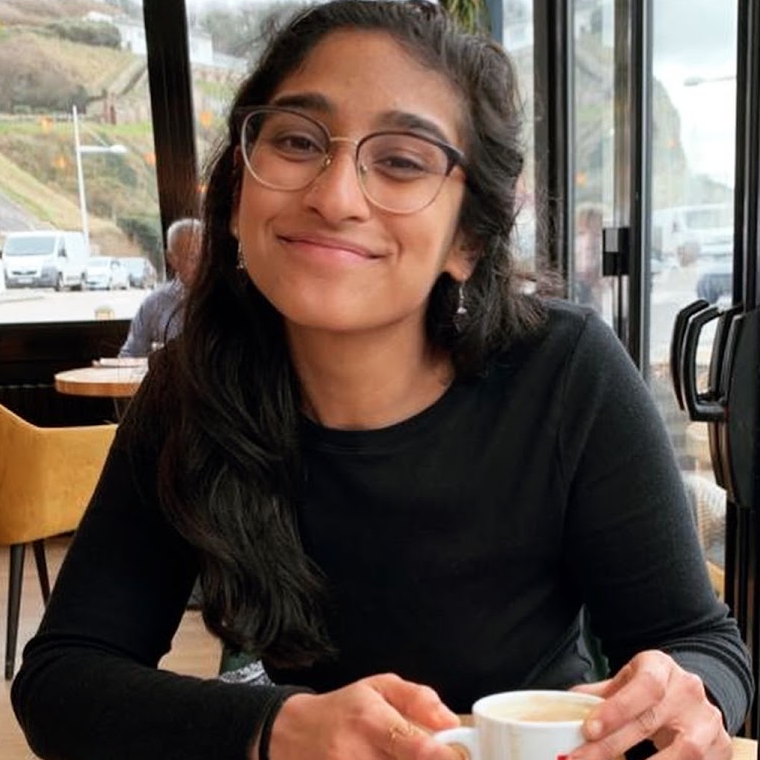
About the author: Mrittika Ghosh (she/her) is a Bengali-American reader, journalist, and communications strategist currently based in Chicago. She holds a BA from Mount Holyoke College and an MA from the University of Chicago, where her focus was on migration and queerness in Francophone and South Asian contexts. She is currently a member of the Muña Art Writing Residency’s 2024 cohort, and has also been a bookseller, educator, and translator.

